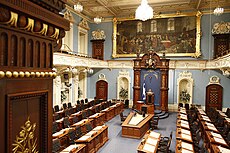Alured Clarke
George III | |
|---|---|
| Preceded by | Sir John Shore |
| Succeeded by | The Earl of Mornington |
| Personal details | |
| Born | 24 November 1744 |
| Died | 16 September 1832 (aged 87) Knight Grand Cross of the Order of the Bath |
| Military service | |
| Allegiance | |
| Branch/service | |
| Years of service | 1759–1802 |
| Rank | Field Marshal |
| Commands | Madras Army Commander-in-Chief of India |
| Battles/wars | American Revolutionary War Fourth Anglo-Mysore War |

Sir Alured Clarke
Military career
Born the son of Charles Clarke (c.1702–1750) and Jane Clarke (née Mullins),[1] Alured Clarke was educated at Eton College and was commissioned as an ensign in the 50th Regiment of Foot on 20 March 1759.[2] Later that year he served in Germany under the Marquess of Granby.[1] Promoted to lieutenant in the 50th Regiment of Foot on 10 May 1760 and to captain in the 52nd Regiment of Foot on 30 December 1763, he transferred to the 5th Regiment of Foot, stationed in Ireland, in January 1767 and was then promoted to major in the 54th Regiment of Foot in 1771.[2]
Promoted to
Clarke became
Clarke was sent to India in 1795 with instructions to interrupt his voyage at the
In 1803 he appeared, alongside Vice-Admiral Nelson and Sir Evan Nepean, as a character witness in the treason trial of Colonel Edward Despard. Together they testified to Despard's service in the Caribbean.[10][11]
Clarke also served as honorary colonel of 1st Battalion 60th Royal American Regiment,[12] of the 68th Regiment of Foot,[13] of the 5th Regiment of Foot[14] and then of the 7th Regiment of Foot.[15]
In retirement, Clarke lived at
Family
Clarke married Elizabeth Catherine Hunter in 1770,[1] who eight years earlier had eloped with the married Earl of Pembroke.[1] Kitty had a son by Pembroke, and received a pension from him until 1790, but Clarke and she had no children.[1]
References
- ^ doi:10.1093/ref:odnb/5485. (Subscription or UK public library membershiprequired.)
- ^ a b c d e Heathcote, p. 89
- ^ "No. 11770". The London Gazette. 13 May 1777. p. 2.
- ^ "No. 13196". The London Gazette. 27 April 1790. p. 258.
- ^ a b "Alured Clarke". Dictionary of Canadian Biography (online ed.). University of Toronto Press. 1979–2016.
- ^ "No. 15434". The London Gazette. 8 December 1801. p. 1465.
- ^ "No. 13976". The London Gazette. 31 January 1797. p. 106.
- ^ "No. 15478". The London Gazette. 8 May 1802. p. 466.
- ^ "No. 16972". The London Gazette. 4 January 1815. p. 18.
- ^ Gurney, William Brodie; Gurney, Joseph (1803). The Trial of Edward Marcus Despard, Esquire: For High Treason, at the Session House, Newington, Surrey, On Monday the Seventh of February, 1803. London: M Gurney. p. 176.
- ISBN 0593051955.
- ^ "No. 13324". The London Gazette. 9 July 1791. p. 399.
- ^ "No. 13693". The London Gazette. 12 August 1794. p. 828.
- ^ "No. 13718". The London Gazette. 28 October 1794. p. 1076.
- ^ "No. 15400". The London Gazette. 22 August 1801. p. 1035.
- OCLC 608094147.
- ^ "No. 18709". The London Gazette. 23 July 1830. p. 1534.
- ^ Heathcote, p. 90
Sources
- Heathcote, Tony (1999). The British Field Marshals, 1736–1997: A Biographical Dictionary. Barnsley: Leo Cooper. ISBN 0-85052-696-5.
Further reading
- "Biography". Dictionnaire des parlementaires du Québec de 1792 à nos jours (in French). National Assembly of Quebec.


